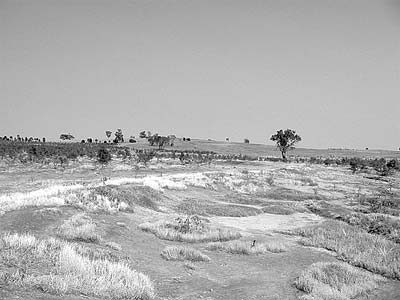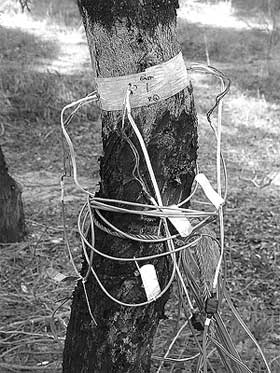


P.G. Walsh, C.V.M. Barton and K.D. Montagu
Peter G. Walsh, Craig V.M. Barton and Kelvin D. Montagu are in the Research and Development Division, State Forests of New South Wales, Beecroft, New South Wales, Australia.
Australian irrigators contribute financially to afforestation in vital catchment areas to reduce dryland salinity.
In Australia, the rapid expansion of agriculture, with extensive clearing of deep-rooted native vegetation, has caused changes in landscape water balances, leading to rapidly expanding areas of salinization. In New South Wales, some major river systems and 120 000 ha of agricultural land have become salinized (Coram, 1998). In addition, the National Land and Water Resources Audit (2000) estimated that in New South Wales 181 000 ha of land had a high potential to develop dryland salinity, with the risk expanding to 1.3 million hectares by 2050 if no changes are made to current land management practices. The total economic impact of salinity is estimated to have already reached US$28 million per year and it is predicted that the costs will continue to rise as the area affected by salinity increases.
The New South Wales Government has recognized the severity of the problem and in 2000 released a strategy for salinity management which provides for an additional expenditure of US$34 million over four years.
The reintroduction of trees into dryland salinity-prone landscapes is seen as a means of halting the spread of salinity (Morris and Collopy, 1999). By transpiring more water than the original agricultural land use, planted trees help to lower groundwater tables and reduce salinity levels. However, the low growth rates of planted forests in these landscapes would not be sufficient to generate an economic return based on wood products alone. To encourage investment in forestry projects, the New South Wales Government is actively engaged in developing markets for non-traditional wood products and environmental services, including not only salinity control, but also biomass for energy generation and charcoal, carbon sequestration and biodiversity enhancement. Traditionally, such products and services have not had a commercial value in New South Wales.
In a pilot project aimed at securing irrigation-quality water, an irrigators’ group in the Macquarie Valley in central western New South Wales has offered a financial incentive to State Forests of New South Wales to establish planted forest on private land in critical recharge areas in the upper reaches of the Macquarie River catchment.
Salinity problems in the Macquarie catchment are estimated to cost agriculture, business and towns US$20 million per year and also pose a significant threat to the biodiversity of the Macquarie marshes (Powell, 2001). In a “business as usual” scenario it has been predicted that the end-of-valley salt load would double by 2020 and salinity would place water supplies for irrigation and towns at risk (Murray-Darling Basin Ministerial Council, 1999).
Under the pilot arrangement, the irrigators’ group, the Macquarie River Food and Fibre Association (MRFFA), will pay State Forests for the salinity control services provided by 100 ha of planted forest. MRFFA represents more than 600 downstream cotton, dairy and horticultural farmers. Since the landholders on whose property the trees are planted will have to take some land out from more profitable uses to plant trees, State Forests will pay the farmers an annuity for the use of their land; it will also pay for establishment and maintenance of the trees. State Forests retains the forestry and timber rights, including carbon benefits.
Ideally, payment should be based on the reduction in recharge that occurs because of the planted forest. However, this would require measurements of the water use of both the forest and the vegetation under the previous land use, incurring high compliance costs. The fee paid by MRFFA is thus based on the transpiration rates of the planted forests (megalitres transpired annually) as a measure of the reduction in recharge. To confirm whether this is a valid measure, State Forests is currently testing the underlying assumption that recharge is reduced compared with pasture and that the amount of reduction in deep drainage is proportional to transpiration rates.
Transpiration varies according to the age of the plantings, seasonal conditions and availability of groundwater. A process model, based on information about weather, tree growth and soils, will be used to estimate tree water use on a daily basis. Actual tree water use will be measured periodically using commercially available sap-flow sensors to check and adjust the model’s predictions.
The trees, comprising the local species Eucalyptus camaldulensis (river red gum), Eucalyptus crebra (narrow-leaved ironbark) and Corymbia maculata (spotted gum), were planted in the spring of 2001 on two blocks of 50 ha each in the Upper Macquarie catchment (see Map). Along with salinity control, the chosen species are suitable for other potential commercial opportunities including carbon sequestration, timber and charcoal production and provision of biomass for energy generation.
This type of market-based solution to dryland salinity management will have several advantages. Both farm-scale reforestation activities and salinity management will be promoted simultaneously. The cost of revegetation will be shared by a number of parties, so that neither landowners in the recharge areas nor purchasers of the salinity management benefits will have to bear all the costs of revegetation. Finally, income from the sale of various goods and services can be bundled together to attract investment in reforestation.
The project is exploring the potential for establishing a system for defining and trading salinity control rights, defined as the right to any legal, commercial or other benefit (whether present or future) arising from the impact of the trees on salinity amelioration, defined in this case by the amount of water transpired by the planted forests. Alternative definitions may be more appropriate in the future. State Forests has made a commitment to develop expertise in valuing environmental benefits from planted forests, as a prelude to potential trading in those benefits.
It is difficult to know at this early stage of the project what the value of a salinity control right will be. It will depend partly on investors’ perceptions of the salinity problem and on how effectively mechanisms can be developed that place an economic value on all of the environmental costs and benefits of different land uses.
Although it is true that 100 ha of planted trees will have only minor impact on dryland salinity in the wider Macquarie catchment, the project will have an impact at the property and subcatchment scales. Understanding at this level is essential to create real confidence in the models (biophysical and economic) that will be used to scale up to the catchment level. The ongoing results of the project, including analysis of the long-term economic impact of changes in land management at the property and catchment scales, will contribute to action plans under the New South Wales Salinity Strategy.
Location of the Macquarie River catchment and the two private properties on which the planted forests for salinity control have been established |
 |
Saline discharge area below a newly established planted forest near Baldry, New South Wales |
 |
P. WALSH |
One-year-old planted forest near Baldry, New South Wales |
 |
P. WALSH |
Heat flow sensors used to estimate transpiration rates of individual trees |
 |
P. WALSH |
 Bibliography
Bibliography
Coram, J. 1998. National classification of catchments for land and river salinity control. Water and Salinity Issues in Agroforestry No. 3. Barton, Australia, Rural Industries Research and Development Corporation (RIRDC).
Morris, J.D. & Collopy, J.J. 1999. Water use and salt accumulation by Eucalyptus camaldulensis and Casuarina cunninghamiana on a site with shallow saline groundwater. Agricultural Water Management, 39: 205-227.
Murray-Darling Basin Ministerial Council. 1999. The salinity audit of the Murray-Darling Basin: a 100 year perspective. Canberra, Australia, Murray-Darling Basin Commission.
National Land and Water Resources Audit. 2000. Australian dryland salinity assessment 2000 – extent, impacts, processes, monitoring and management options. Available on the Internet: audit.ea.gov.au/ANRA/land/docs/national/Salinity_Contents.html
Powell, J. 2001. Revegetation for salinity management in the Macquarie Valley: a case study in the Murray-Darling Basin. In E.K.S. Nambiar & A.G. Brown, eds. Plantations, farm forestry and water. Proceedings of a National Workshop, Melbourne, Australia, 20-21 July 2000. RIRDC Publication No. 10/20. Barton, Australia, RIRDC.